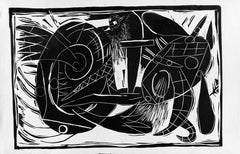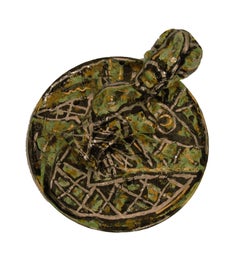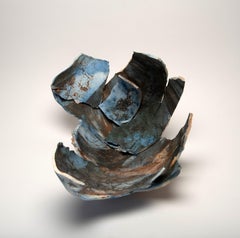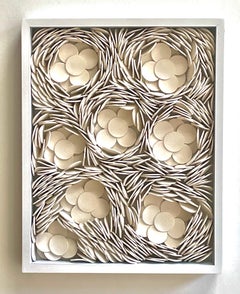Carlos Alfonzo Art
Cuban, 1950-1991
In July of 1980, Carlos Alfonzo left Cuba in exile through the port of Mariel and arrived in Miami. At an early stage of his youth on the island, Alfonzo’s creative talent became apparent, an endowment he began to cultivate through formal artistic studies at the prestigious San Alejandro Academy and the University of Havana from 1969 to 1977. Carlos Alfonzo became disenchanted with the regime as a young man living and working within the Cuban system, cautiously navigating the emotional and artistic repressions of post-revolutionary life. Carlos Alfonzo decided to leave Cuba just eight months before the pivotal Volumen 1 (Volume 1) exhibition that heralded a new international direction in contemporary Cuban Art and where Alfonzo was slated to exhibit among those who would later become known as the “1980s generation.” With hopes of finally living an open life as an individual and artist, he endured a traumatic crossing via the Mariel boatlift to settle in Miami.
Within the decade following his exile, the young artist and political refugee were awarded a Visual Artist Fellowship in Painting from the National Endowment of the Arts in Washington D.C., a Cintas fellowship in the Visual Arts, and his work was exhibited in solo and group shows on a national and international scale including the 1991 Whitney Biennial, the exhibition entitled Hispanic Art in the United States which traveled to seven prominent American institutions, and the 41st Biennial Exhibition of Contemporary American Painting at Corcoran Gallery. Today, his work forms part of the permanent collections of the Whitney Museum of American Art, the Hirshhorn Gallery and Sculpture Garden, The Smithsonian American Art Museum, and numerous institutions of worldwide prominence.
Alfonzo’s style developed significantly, and his career as an artist matured during a period in which neo-expressionist figurative Art came to renewed global attention. As he was exposed to great works of modernist and contemporary Art in America, he internalized various styles – cubist, surrealist, expressionistic, and abstract expressionist – and adapted them to his free-flowing expression resulting in a style discernibly his own. A magical body of work emanated, combining intense autobiographical experience with cross-cultural mythologies in an oeuvre laden with penetrative, intimate messaging that recounts the soul and struggle of the artist’s life experience through a stark, resonant system of forms. Alfonzo employs the spiritual iconography of African deities, Catholicism, and the ritualistic emblems of Santería in heads, disembodied facial features, daggers, and arrows to hauntingly convey eternal paradoxes of the human condition and the unconscious, an impression recognized by the leading art critics of the era. Carlos Alfonzo emerged not simply as a Latin American artist but as a celebrated artist of the Americas.(Biography provided by Latin Art Core)
to
2
1
1
1
Overall Height
to
Overall Width
to
2
2
2
6,958
3,331
2,514
1,213
1
1
Artist: Carlos Alfonzo
Untitled 1988 Artist Proof
By Carlos Alfonzo
Located in Miami, FL
Alfonzo's style developed significantly, and his career as an artist matured during a period in which neo-expressionist figurative art came to renewed global attention. As he was exp...
Category
1980s Carlos Alfonzo Art
Materials
Linocut
Green Ceramic Woman on a Plate, colorful, abstract
By Carlos Alfonzo
Located in New York, NY
A plate with a green and yellow ceramic woman's body from waiter up attached on it.
Signed and dated verso.
Born in Havana in 1950, Alfonzo w...
Category
1980s Carlos Alfonzo Art
Materials
Ceramic
Related Items
"Ocean Canyon", ceramic sculpture, porcelain shards, saggar, blue, rust Kintsugi
By Alison Brannen
Located in Toronto, Ontario
"Ocean Canyon" is a saggar-fired porcelain sculpture by Alison Brannen. It measures 13" high by 9" wide by 9" deep, however the sculpture can be arrange...
Category
21st Century and Contemporary Contemporary Carlos Alfonzo Art
Materials
Ceramic, Clay, Porcelain
Lapis 618 - white 3D abstract floral geometric ceramic composition
By Marie Laforey
Located in New York, NY
Marie Laforey is a self-taught artist based in New York, US who maintains a sustainable art practice using primarily organic material. Laforey enjoys the tactility of working with organic mediums and learning how to craft preserved moss...
Category
2010s Contemporary Carlos Alfonzo Art
Materials
Clay
H 19 in W 15 in D 2.75 in
Ceramic and textile small sculpture: 'No. 19'
By Ak Jansen
Located in New York, NY
This is part of a collection of ceramics, textiles, and drawings by Ak Jansen which comprise his first solo show in New York City. Born in the Netherlands, Jansen’s work occupies que...
Category
2010s Contemporary Carlos Alfonzo Art
Materials
Gold
Abstract Landscape India Rajasthan Light Natural Mustard Earth Blue Yellow
By Mukesh Sharma
Located in Norfolk, GB
There is a natural and raw understanding in Mukesh Sharma’s prints that depict, and are influenced by, the Rajastani communities of his home town in rura...
Category
1990s Abstract Carlos Alfonzo Art
Materials
Archival Paper, Linocut, Archival Ink
Free Shipping
H 31.11 in W 21.66 in
California Abstract Expressionist Linocut Lithograph Sepia Print Edition of 6
By Hans Burkhardt
Located in Surfside, FL
Untitled, 1983, lithograph printed in sepia ink,
Hand signed and dated lower right, numbered in pencil with the artist's chop mark lower left, inscribed
by artist. From a series of experimental abstract linocuts done in 1983. These are very small editions and were gifted to a friend of the artist. They are done on deckle edged French Arches Art paper.
Hans Gustav Burkhardt (1904 – 1994) was a Swiss-American abstract expressionist artist.
Hans Burkhardt was born in the industrial quarter of Basel, Switzerland. Captivated by Germanic art, he began dabbling in art in his spare time while learning how to decorate furniture in antique styles. He became foreman of the furniture company's decorating department. From 1925 to 1928 he attended the Cooper Union School of the Arts, where he befriended mentor Arshile Gorky and Willem de Kooning—sharing Gorky's studio from 1928 to 1937.
Burkhardt's paintings of the 1930s are part of the genesis of American abstract expressionism. In 1937 he moved to Los Angeles and represented the most significant bridge between New York and Los Angeles. His experimental investigative approach paralleled, and in many instances anticipated, the development of modern and contemporary art in New York and Europe including the work of Mark Rothko, Jackson Pollock, and Barnett Newman.
Burkhardt held his first solo exhibition in 1939 at Stendahl Gallery in Los Angeles, arranged by Lorser Feitelson, and, in response to the Spanish Civil War, he painted his first anti-war works. From the late 1930s he began to produce apocalyptic anti-war compositions, a theme which became particularly pronounced in an abstract expressionist style after the atom bomb was dropped on Hiroshima and Nagasaki at the end of the Second World War. In the years following an acclaimed (1945) solo exhibition at the Los Angeles County Museum, Burkhardt continued in his art to respond to WWII, in the aftermath of Gorky's suicide in 1948, Burkhardt delved into his grief and celebration of Gorky's life creating several versions of “Burial of Gorky” and a series entitled “Journey into the Unknown.” Burkhardt first visited Mexico in 1950, and spent the next decade living half of the year in and around Guadalajara. Strongly influenced by Mexican attitudes towards the dead, and by the country's colors, sensuality, and spiritual qualities, Burkhardt “painted the soul of Mexico” with Mexican themes and colors—especially those of burials and ceremonies surrounding death—permeating his abstract work. His Mexican work flirted with Surrealism although he was never really considered a Surrealist artist. Art critics of the time considered him a "great Mexican master” alongside Orozco, Diego Rivera, and Siqueiros, and Rufino Tamayo admired his work. Overall, in the 1950s Burkhardt held 23 solo exhibitions in Los Angeles and Mexico, and participated in group shows at over thirty museums worldwide. He was friends with June Wayne from Tamarind Press.
In the 1960s he produced paintings in protest against the Vietnam War, some of which incorporated the human skulls he had collected from Mexican graveyards. As art historian Donald Kuspit stated, Burkhardt was “a master—indeed the inventor—of the abstract memento mori.” In 1964, for the first time in forty years, Burkhardt returned to Basel, and began making annual summer visits where he became a friend of Mark Tobey—printing linocuts for the artist and collecting his work. In the 1970s Burkhardt continued his anti-war paintings—incorporating protruding wooden spikes into the canvas—while simultaneously painting abstractions of merging lovers and cityscapes during his summer visits to Basel. His “Small Print” (protesting smoking), “Graffiti,” and “Northridge” series demonstrate the evolution of his symbolism, and his “Desert Storms” series, in response to Iraq's invasion of Kuwait, was discussed by critic Peter Selz at a presentation at the International Congress of Art Critics Conference.
In the last decades of his life, Burkhardt's work had moved from images of imbalance to a study of human tragedy—which he embraced in an attempt to discover beauty and facilitate understanding. Critic Peter Frank called Burkhardt “…one of America’s most vital abstract expressionist painters, someone who took the seed of the movement and cultivated it a rather different way in very different soil.”
Burkhardt taught at numerous colleges and universities and retired as a professor emeritus from California State University, Northridge. In 1992 Burkhardt was honored as the recipient of the Lifetime Achievement Award by the American Academy and Institute of Arts and Letters’ Jimmy Ernst (son of Max Ernst) Award. Also in 1992, he established the Hans G. and Thordis W. Burkhardt Foundation. In 1993, the last year of his career, his final series “Black Rain” channeled pain and hardship, but provided poignant, symbolic beacons of hope and wishes for a better future for humanity. His unique role as an important American painter is affirmed by the constant interest and continuing reassessment afforded his work.
Select Solo exhibitions
1939: Stendahl Gallery, Los Angeles, March 27 – April 17
1945: Hans Burkhardt, Los Angeles County Museum of Art
1951: Museo de Bellas Artes, Guadalajara, Mexico: Exhibición de Pinturas Modernas; Comara Gallery, Los Angeles
1953: Fisher Gallery, University of Southern California, Los Angeles
1957: Pasadena Art Museum, California: Ten Year Retrospective, June 14 – July 14;
1968: San Diego Museum of Art: Vietnam Paintings...
Category
1980s Abstract Expressionist Carlos Alfonzo Art
Materials
Lithograph, Linocut
Abstract Landscape Rajasthan Print Nature Multicultural Faces Earth Orange Brown
By Mukesh Sharma
Located in Norfolk, GB
There is a natural and raw understanding in Mukesh Sharma’s prints that depict, and are influenced by, the Rajastani communities of his home town in rura...
Category
Early 2000s Abstract Carlos Alfonzo Art
Materials
Archival Ink, Archival Paper, Linocut, Archival Pigment
Free Shipping
H 27.56 in W 21.66 in
'Segments' — 1930s Geometric Abstraction
By Josef Albers
Located in Myrtle Beach, SC
Josef Albers, 'Segments', linoleum cut, 1934, edition 20, 25, plus proofs, Danilowitz 79. Signed, titled, dated, and annotated '(proof)' in pencil. A fine, richly-inked impression on...
Category
1930s Abstract Geometric Carlos Alfonzo Art
Materials
Linocut
Abstract Landscape India Edition 3/5 Linocut Print Nature Red Orange Black
By Mukesh Sharma
Located in Norfolk, GB
There is a natural and raw understanding in Mukesh Sharma’s prints that both depict, and are influenced by, the Rajastani communities of his home town in rural India. In these Limited Edition fine-art prints, made over a period of twenty years, we are offered the colours of India’s ancient land, the textures, light and the patterns that are everywhere. In the patterns of the arable fields to the jali's (carved screens) in the architecture. This work is however not romantic nor nostalgic but shows a deeper rooted need to offer a visual heritage of place, of where the artist is from and the journey that he is taking. The results are both compelling and honest.
Mukesh Sharma, Celebration “O”, Lino-cut chin-coll’e on German Ivory paper
Edition: 3 of 5, 2005
Image size: 50 x 33 cm / Sheet size: 79 x 55 cm
Unframed
"In this piece I use multiple layering of image, repetition of shape, layered shapes to inform my life celebration and my investigation into Indian culture"
Mukesh Sharma's work:
It is often in childhood that paths are set for what we will become. Mukesh Sharma hails from a rural, agricultural village in Rajasthan, India. His Father is a craftsman who fixed and mended farm machinery and understood the working parts in the processes. Sharma followed in his Father’s footsteps, as is often the case in Indian families, but his was not the machines of the fields but the presses of the printing studio.
Like his Father, Mukesh Sharma is fascinated with understanding how things work and how he can manipulate the metal in his hands. It is not surprising then that his medium of choice is printing. One of the most physically challenging of all the practices, it can often be physically challenging as well as technical and detailed.
In his youth, Sharma would draw with stones on walls and floors. He was lucky his family encouraged this and he is grateful for his early art-training at the Jaipur School of Art but it was at the Baroda Art Department that he was introduced to the great printing traditions of Jyoti Bhatt...
Category
Early 2000s Abstract Carlos Alfonzo Art
Materials
Archival Ink, Archival Paper, Linocut, Archival Pigment
Free Shipping
H 31.11 in W 21.66 in
"MIDNIGHT BLUE", sculpture, clay, relief, abstract, contemporary, ceramic
By Harold Wortsman
Located in Toronto, Ontario
Midnight Blue, a ceramic relief sculpture of high-fired porcelain pigmented with oxides, paint and epoxy, is a recent work by New York artist Harold Wortsman. This sculpture is ready to be mounted to the wall. Note the artist's hand in the mark-making – cuts and radiating lines, the suggestion of maps, geometry and counting systems – it is characteristic of Wortsman's practice. Warm, contemporary, uniquely crafted, yet speaks to ancient, tribal traditions of art-making that cross cultures and histories. Highly attuned to the art of Africa, the Middle East, India and Asia, his forms are organic abstracts with masculine and feminine attributes that resonate together as a pleasing enigma. They make sense immediately, yet never give up all their secrets.
Midnight Blue was recently exhibited at Harold Wortsman: Time and Space, Orange Art Foundation, New York City, February 2022.
From Harold Wortsman – "With sculpture, my material of choice is high-fired clay. Pieces are first low-fired in an electric kiln. I do not use glazes. Instead, I use oxides applied to the bisqued (low-fired) clay. As with a tattoo, oxides permit the surface underneath to breathe—like naked skin. The work is then high-fired in a gas kiln with double reduction to cone 10. The final temperature is 2,300 degrees F. At a certain point, oxygen intake is reduced to the kiln. Because the fire has reached a critical mass, it needs oxygen and chemically takes it from the clay and the oxides painted on. Like a jazz improvisation, each kiln load comes out slightly different."
From Jonathan Goodman – "Wortsman has increasingly moved into his own – a place in which the relations between the abstractions of volume and the intimations of very old culture are merged in a way that is new." – Essay, "Harold Wortsman: Time and Space", Orange Art Foundation, February 2022, New York City.
Harold Wortsman is a sculptor and printmaker based in Brooklyn, NY. He “creates forms that bring to mind archaic cult objects and exude a quiet concentrated strength.” (Argauer Zeitung, Switzerland). His work, an edgy mix of freedom and clarity, can be found in public and private collections in the US, including The Library of Congress, Yale University, The New York Public Library Print Collection, The New York Historical Society, Smith College, Indiana University’s Lilly Library, Brandeis University, The Newark Public Library Special Collections Division, and the Jane Voorhees Zimmerli Art Museum Print Archive. Also in private and public collections in Europe, including the Municipal Collection of the City of Brugg, Switzerland.
Harold studied at the New York Studio School of Drawing, Painting and Sculpture, with sculptor George Spaventa...
Category
21st Century and Contemporary Contemporary Carlos Alfonzo Art
Materials
Ceramic, Clay, Pigment, Other Medium, Porcelain, Epoxy Resin
"Midnight Over Mountains", ceramic sculpture, porcelain shards, blue, copper
By Alison Brannen
Located in Toronto, Ontario
"Midnight Over Mountains" is a saggar-fired porcelain wall sculpture by Alison Brannen. It measures 15" high by 15" wide by 7" deep, however the sculptu...
Category
21st Century and Contemporary Contemporary Carlos Alfonzo Art
Materials
Ceramic, Clay, Porcelain
Abstract India Edition 5/8 Linocut Print Nature Orange Black Red Love
By Mukesh Sharma
Located in Norfolk, GB
There is a natural and raw understanding in Mukesh Sharma’s prints that both depict, and are influenced by, the Rajastani communities of his home town in rural India. In these Limited Edition fine-art prints, made over a period of twenty years, we are offered the colours of India’s ancient land, the textures, light and the patterns that are everywhere. In the patterns of the arable fields to the jali's (carved screens) in the architecture. This work is however not romantic nor nostalgic but shows a deeper rooted need to offer a visual heritage of place, of where the artist is from and the journey that he is taking. The results are both compelling and honest.
Mukesh Sharma, Voted Dyas II, Lino-cut/ chine colle, on German Ivory paper
Edition: 5 of 8, 1999
Image size: 47 x 39 cm / Sheet size: 79 x 55 cm
Unframed
'We belong where love finds us'
Mukesh Sharma's work:
It is often in childhood that paths are set for what we will become. Mukesh Sharma hails from a rural, agricultural village in Rajasthan, India. His Father is a craftsman who fixed and mended farm machinery and understood the working parts in the processes. Sharma followed in his Father’s footsteps, as is often the case in Indian families, but his was not the machines of the fields but the presses of the printing studio.
Like his Father, Mukesh Sharma is fascinated with understanding how things work and how he can manipulate the metal in his hands. It is not surprising then that his medium of choice is printing. One of the most physically challenging of all the practices, it can often be physically challenging as well as technical and detailed.
In his youth, Sharma would draw with stones on walls and floors. He was lucky his family encouraged this and he is grateful for his early art-training at the Jaipur School of Art but it was at the Baroda Art Department that he was introduced to the great printing traditions of Jyoti Bhatt...
Category
Early 2000s Abstract Carlos Alfonzo Art
Materials
Archival Ink, Archival Paper, Linocut, Archival Pigment
Free Shipping
H 31.11 in W 21.66 in
Color Lithograph Linocut Chine Collé "Workshop" Bright Modernist Pop Art
By Tom Burckhardt
Located in Surfside, FL
Hand signed and numbered edition of 25. 16 x 36" sheet size without frame.
“Workshop” is an ambitious color lithograph and linocut with chine collé printed in twelve colors from nine plates and one linocut. It has been printed in an edition of 25, plus proofs, on white Rives BFK paper 16 x 36” with chine collé of various papers. (No, it’s not upside down)
Born 1964 in New York where he still currently resides and works alongside his partner the ceramist Kathy Butterly. Son of the photographer Rudy Burckhardt and painter Yvonne Jacquette, Tom Burckhardt was 1986, BFA, State University of New York, Purchase, NY
1992–1993, Skowhegan School of Painting and Sculpture, ME
1996, Marie Walsh Sharpe Art Foundation Studio Grant
1997, New York Foundation for the Arts, Painting Grant
1997 Pollock-Krasner Foundation Grant
2002 George Hitchcock Award, National Academy of Arts
2003, Richard & Hinda Rosenthal Foundation Award, American Academy
2005, AICA Best Show of an Emerging or Underknown Artist
2005 Pollock-Krasner Foundation Grant
2006 Best Installation, Best of Houston, the Houston Press
2009 Guggenheim Foundation Grant
2010, New York Foundation for the Arts Drawing/Print Grant
2010 Joan Mitchell Foundation Grant
Tom Burckhardt’s work is a carnival of images jumbled and jostling each other in precarious nonsensical compositions. He uses lushly colored and patterned images from all kinds of sources that bounce between abstraction and representation. Images come from tool catalogs, paper and fabric patterns, funhouse painting, architectural details, stripes, dots and squiggles. It is as if Burckhardt is a cartoonist merrily channeling Ellsworth Kelly, Paul Feeley, Robert Therrien, and Myron Stout, among others. Like Red Grooms, for whom he worked as an assistant, Burckhardt ransacks his influences yet ends up with something unmistakably his own. His work bears the influence of is a synthesis of many things: the tribal-influenced abstract painting of Steve Wheeler...
Category
Early 2000s Pop Art Carlos Alfonzo Art
Materials
Linocut, Lithograph
Carlos Alfonzo art for sale on 1stDibs.
Find a wide variety of authentic Carlos Alfonzo art available for sale on 1stDibs. You can also browse by medium to find art by Carlos Alfonzo in linocut and more. Not every interior allows for large Carlos Alfonzo art, so small editions measuring 15 inches across are available. Customers who are interested in this artist might also find the work of Agustín Fernández, Wifredo Lam, and Carmen Herrera. Carlos Alfonzo art prices can differ depending upon medium, time period and other attributes. On 1stDibs, the price for these items starts at $3,500 and tops out at $3,500, while the average work can sell for $3,500.



